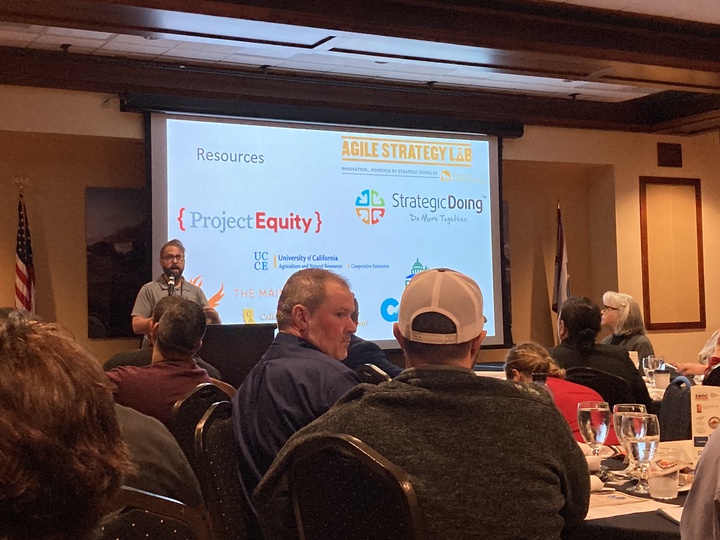Jessica Cejnar Andrews / Friday, May 19, 2023 @ 4:45 p.m. / Environment, Ocean, Our Culture
Offshore Wind Is Coming, And Del Norte Can Benefit, U.C. Davis Prof Tells Economic Summit

U.C. Davis community economic development professor Keith Taylor discusses offshore wind development benefits with Del Norte on Friday. | Photo: Jessica C. Andrews
Though the current focus is on Humboldt County and Morro Bay, wind turbines will spin off Del Norte County’s coast. The question is, how does the community take advantage of that, UC Davis Professor Keith Taylor said.
Speaking before a collection of business representatives, nonprofits and local government officials at the Del Norte Economic Summit on Friday, Taylor whose field is community economic development and who also works with the UC Cooperative Extension, pointed out that entities looking to harness offshore wind are extracting resources from the community.
The author of “Governing the Wind Energy Commons: Renewable Energy and Community Development,” Taylor brought up the pros and cons of investor-owned companies versus electric co-ops as well as the importance of community benefit agreements with wind energy developers.
He also pointed out that the jobs many energy companies say they’re going to create are short-term.
“I understand rural communities feel like they’re resource-constrained, but there’s a ton of stuff out there, especially in a state like California,” Taylor said. “If you engage, you’ll find there’s a ton more resources out there than you knew.”
Taylor’s presentation came two days after State Sen. Mike McGuire, Chair of the Joint Committee on Fisheries and Aquaculture, held a hearing discussing the next steps with floating offshore wind development on the West Coast.
Late last year, the Bureau of Ocean Energy Management (BOEM) auctioned off five leases — two off Humboldt Bay and three off Morro Bay. BOEM finalized and executed the lease agreements this week, the Lost Coast Outpost reported Thursday. BOEM’s next steps are developing communication plans for fisheries, local tribes and federal and state agencies, Jen Miller, BOEM’s chief of the Renewable Energy Section for the Pacific Region, said during the hearing.
Taylor urged Del Norte representatives, both in government and local business, to reach out to other communities who have experience with community benefit agreements. He also urged the community to explore different models for benefitting from offshore wind energy development such as compacts and joint powers authority.
“With community benefits agreements, you want to think in depth about what you can ask for from wind energy companies,” he said, this includes thinking about workforce and small business development locally as well as arts and culture. “How do you create this local community wealth where people feel like they’re invested and they have ownership and new economic development along the way. You want to have a very participatory structure where you can identify local needs so people feel like they’re included.”
The Wild Rivers Community Foundation and Humboldt Area Foundation are already involved in much of this work in Humboldt County, said Michelle Carrillo, the foundations’ vice president for strategy and community solutions.
The Humboldt Area Foundation and Wild Rivers Community Foundation launched the Redwood CORE Hub as a way to bring academic, legal and policy experts as well as state, federal and tribal agencies together to understand “what’s coming and how can we navigate it.”
Community benefit agreements are part of that, Carrillo said, and while they do deal with workforce housing, labor and fisheries, they touch on other needs such as investment sin local child care programs, health infrastructure and legal systems.
Carrillo pointed out that many wind energy developers adopt a strategy of divide and conquer when it comes to working with local communities. Wind energy developers had initially proposed a shared revenue model of 10-15 percent to direct those dollars into the community.
That wasn’t good enough, Carrillo said. Speaking on behalf of local governments and tribal nations, Redwood CORE Hub responded, saying the shared revenue model should be 50-50.
“The sale notice happened at the end of last year, and it was like over $300 million for the sale notice and we were able to negotiate,” she said. “It went from that 10-15 percent to 30 percent and that impact was because people worked together and they were stronger in this together.”
The Humboldt Area Foundation and Wild Rivers Community Foundation set its priorities on what thecomunities say is important, she said.
In Del Norte County, wind energy is a focus for the revitalized Tri-Agency Economic Development Authority, a joint powers authority consisting of Crescent City, the Crescent City Harbor District and the county.
Citing Cal Poly Humboldt’s Schatz Energy Lab, the Tri-Agency’s spring 2023 work plan states that understanding the negotiations strategy and structure of community benefit agreements are key areas to “get ahead of the curve on.”
The Tri-Agency’s plan also mentions transmission and landing areas, saying that it has the opportunity to influence where those lines can be directed.
“There is the possibility for landing fees or discounted power which could provide ongoing benefits for Del Norte,” the plan states.
District 3 Supervisor Chris Howard, one of three county supervisors who approved earmarking $70,000 in the county’s 2023-24 budget for the Tri-Agency, said wind energy is a “natural landing platform” for the JPA. But he wasn’t aware that the Humboldt Area Foundation was addressing the issue down south.
Referring to Taylor’s suggestion that local government representatives explore different models for taking advantage of wind energy development, particularly the Anza Electric Cooperative in Southern California, Howard said Del Norte County needs to be unified.
“Why can’t we own this power and why can’t we provide a lower rate for consumers?” Howard asked. “Why not look at Anza and the work they’ve done and see how it could benefit the community?”
CLICK TO MANAGE